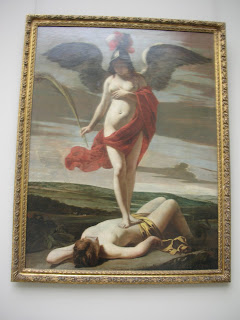 This is the famous glass pyramid designed by I.M. Pei. Initially, people were quite upset about it because they didn't feel that it fit in with the classic architecture surrounding it, but I think it actually looks pretty cool. Whether you like the pyramid or hate it, you have to admit that it isn't very practical. The pyramid leaks when it's raining heavily and during the summer when it gets really hot, the pyramid functions like a greenhouse and amplifies the heat. People have fainted while waiting in line inside the pyramid because of the heat. While the Louvre is one museum, it is made up of four buildings, linked by the lobby underneath the glass pyramid. It's an immense place and if you want to see everything in it and stop for a minute beside each piece, it would take you four months to cover the whole museum.
This is the famous glass pyramid designed by I.M. Pei. Initially, people were quite upset about it because they didn't feel that it fit in with the classic architecture surrounding it, but I think it actually looks pretty cool. Whether you like the pyramid or hate it, you have to admit that it isn't very practical. The pyramid leaks when it's raining heavily and during the summer when it gets really hot, the pyramid functions like a greenhouse and amplifies the heat. People have fainted while waiting in line inside the pyramid because of the heat. While the Louvre is one museum, it is made up of four buildings, linked by the lobby underneath the glass pyramid. It's an immense place and if you want to see everything in it and stop for a minute beside each piece, it would take you four months to cover the whole museum.I didn't get to see it for very long, I was only able to stay for about an hour and a half and I didn't get to see anything famous, but I did see things that I liked. As at most museums, you are prohibited from taking pictures inside the Louvre. Despite this fact, everyone does it anyway, so here are some of the pictures I managed to take. For the most part, I tried to do without the flash (so as not to attract the attention of the guards, for one, and also I figured it was a bit more respectful) but here are some of the photos that actually came out relatively well.






 If you can't figure out from just looking at it, this is a painting of Cardinal Richelieu. I actually think that Tim Curry is quite a good likeness for him in The Three Musketeers movie, even if the plot is entirely untrue to the reality of the situation.
If you can't figure out from just looking at it, this is a painting of Cardinal Richelieu. I actually think that Tim Curry is quite a good likeness for him in The Three Musketeers movie, even if the plot is entirely untrue to the reality of the situation. This one is the Roman goddess Diana and I wish I'd taken a picture of the plaque that said who'd painted it, because I can't remember, but I think it's lovely anyway.
This one is the Roman goddess Diana and I wish I'd taken a picture of the plaque that said who'd painted it, because I can't remember, but I think it's lovely anyway. This painting is an allegory of Charity, from around 1560, painted by Ecole de Fontainebleau.
This painting is an allegory of Charity, from around 1560, painted by Ecole de Fontainebleau.
The photo is quite blurry but I've included it here anyway because the painting was quite lovely.
 This belonged to Charles IX, circa 1572
This belonged to Charles IX, circa 1572 A ceremonial sword and scabbard belonging to Charlemagne. While most people tend to focus on the famous paintings and sculptures in the Louvre, they've got quite an impressive collection of antiquities, including Greek, Etruscan, Roman and Middle-Eastern relics as well as French ones. Well worth looking at and far less crowded than the galleries with the Venus de Milo and the Mona Lisa.
A ceremonial sword and scabbard belonging to Charlemagne. While most people tend to focus on the famous paintings and sculptures in the Louvre, they've got quite an impressive collection of antiquities, including Greek, Etruscan, Roman and Middle-Eastern relics as well as French ones. Well worth looking at and far less crowded than the galleries with the Venus de Milo and the Mona Lisa.


Did you see the Mona Lisa?
ReplyDeleteNo, I didn't see anything famous, unfortunately, primarily because I was short on time, but also because I got lost (the place is huge!!). Kept trying to find the famous bits but only ended up looking at a bunch of tapestries, which, while interesting, were something of a let-down.
ReplyDelete